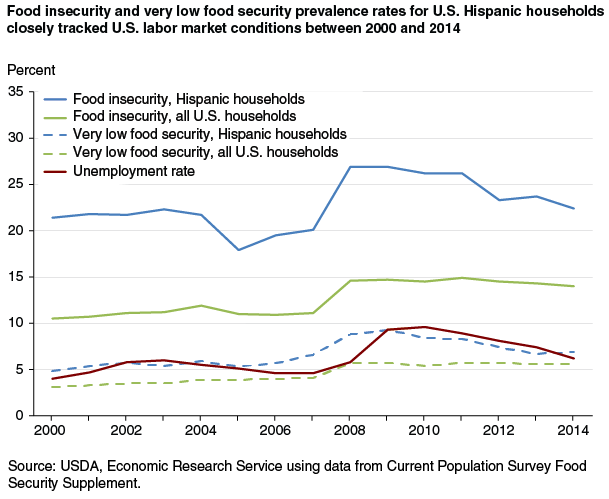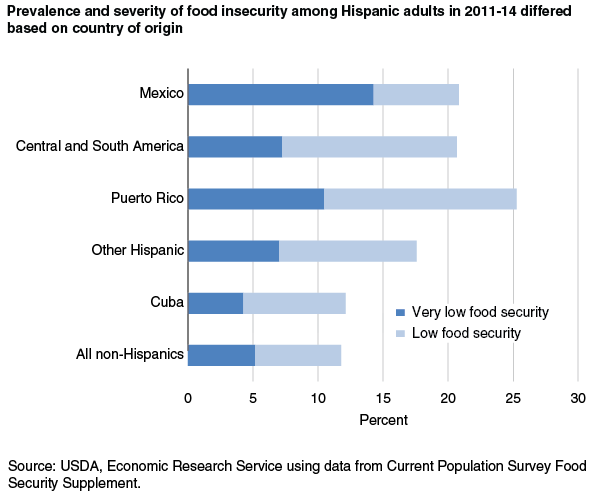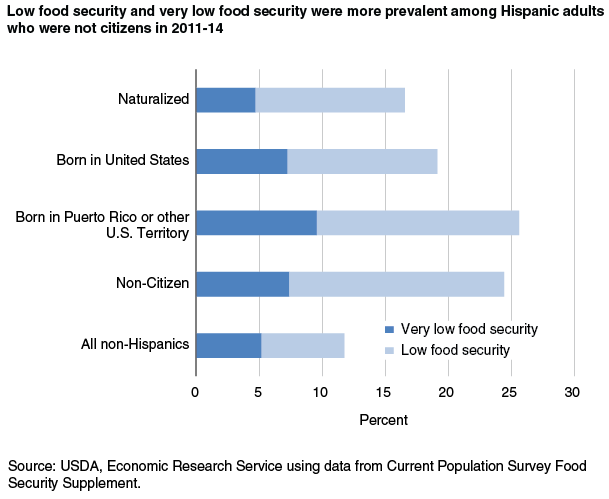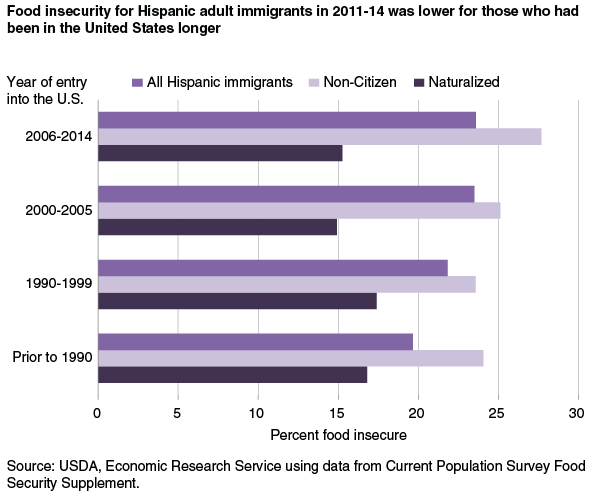Food Insecurity and Hispanic Diversity
- by Matthew P. Rabbitt, Michael D. Smith and Alisha Coleman-Jensen
- 7/5/2016
In 2014, 22.4 percent of U.S. Hispanic households were food insecure—significantly higher than the national average (14.0 percent). Food-insecure households have difficulty consistently obtaining adequate food for all household members because of limited economic resources for food. The prevalence of very low food security, a more severe level of food insecurity in which the food intake of one or more household members is reduced and normal eating patterns are disrupted at times, was also higher for Hispanics (6.9 percent) than for all U.S. households (5.6 percent) in 2014.
Between 2000 and 2014, the prevalence of food insecurity for Hispanic households followed U.S. labor market conditions, as measured by the unemployment rate, more strongly than did food insecurity for the Nation as a whole.
As of 2014, over 55 million Hispanics are living in the United States, making up 17 percent of the U.S. population. According to the U.S. Census Bureau, 64.0 percent of the U.S. Hispanic population reported being of Mexican origin (the individual’s place of birth or that of his or her parents or ancestors), 9.5 percent reported Puerto Rican origin, 3.8 percent Salvadoran origin, 3.7 percent Cuban origin, 3.2 percent Dominican origin, and 2.4 percent Guatemalan origin. The remaining 13.4 percent reported being of some other Hispanic origin.
Economic circumstances vary considerably across Hispanic origin groups and may reflect differences in poverty rates, immigration status, and length of time in the United States. For example, according to the U.S. Census Bureau, poverty rates for Hispanics in 2007-11 ranged from a low of 16.2 percent for those of Cuban origin to a high of 26.3 percent for those of Dominican origin. Hispanics of Salvadoran origin had a poverty rate of 18.9 percent, and Hispanics with origins of Mexico, Guatemala, and Puerto Rico had rates of around 25 percent each.
A new ERS report, Food Security Among Hispanic Adults in the United States, 2011-2014, provides a detailed look at differences in the prevalence and severity of food insecurity among U.S. Hispanics. Prior research on food insecurity among Hispanics categorized them as a single group. ERS’s new report describes food insecurity among Hispanic adults by origin, immigration status, State of residence, and time in the United States. Food-insecurity statistics are reported for Hispanic adults age 18 and older living in food-insecure households because many of the relevant characteristics of the Hispanic population are measured at the individual level. For example, one household member may be a citizen while another is not, or two immigrant adults in the same household may have been in the United States for different lengths of time. Food insecurity in 2011-14 among U.S. Hispanic adults was least prevalent for those identifying themselves as having Cuban origins and most prevalent for those from Puerto Rico.
Differences in the prevalence of food insecurity and very low food security also exist based on immigration status. In 2011-14, food insecurity among U.S. Hispanic adults was more prevalent among those who were noncitizens (24.4 percent) than among those born in the United States (18.9 percent). Hispanic adults who were naturalized citizens had lower rates of food insecurity and very low food security than other U.S. Hispanic adults.
The incidence of food insecurity was lower for Hispanic adult immigrants who have been in the United States longer than other Hispanic immigrants. Among all those who arrived prior to 1990, 19.7 percent were food insecure in 2011-14, compared with about 24 percent of those who arrived since 2000. Across all year-of-entry categories, naturalized citizens had lower food insecurity rates than noncitizens.
This article is drawn from:
- Rabbitt, M.P., Smith, M.D. & Coleman-Jensen, A. (2016). Food Security Among Hispanic Adults in the United States, 2011-2014. U.S. Department of Agriculture, Economic Research Service. EIB-153.
You may also like:
- Food Security in the U.S.. (n.d.). U.S. Department of Agriculture, Economic Research Service.
- Coleman-Jensen, A., Rabbitt, M.P., Gregory, C.A. & Singh, A. (2015). Household Food Security in the United States in 2014. U.S. Department of Agriculture, Economic Research Service. ERR-194.





